Astronomy Exam 2
1/90
There's no tags or description
Looks like no tags are added yet.
Name | Mastery | Learn | Test | Matching | Spaced |
|---|
No study sessions yet.
91 Terms
Luminosity
Total amount of power (energy per second = watts) the star radiates into space, what is the energy output of the star, it’s a measure of power.
Apparent brightness/Flux
how bright does it appear to us in terms of power? → Depends on luminosity and distance, amount of starlight (power) that reaches Earth (in energy per second per square meter) = watts/m²
Inverse square law
An effect's intensity is inversely proportional to the square of the distance from its source
The amount of luminosity passing through each imaginary sphere around the star is the same, but each little square causes for the light to be divided among them so like at 3AU, each square receives 1/9 as much light as the 1AU square
→ The surface area of the sphere depends on its distance from the star
Area of sphere: 4pi (radius)^2
Radius of the sphere = distance from star to us or wtv
Example: If you double the distance from a star, the energy is spread over four times the area, making the star appear four times dimmer
Divide luminosity by area to get apparent brightness
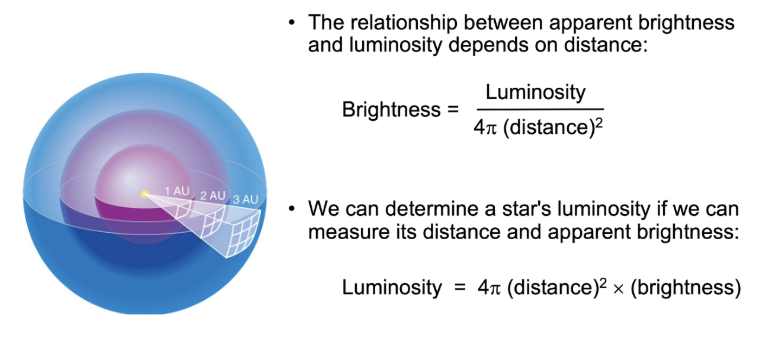
Parallax
The apparent shift in position of a nearby object against a background of more distant objects
→ Depending on where the Earth is (it’s doing the moving), the apparent position of the nearest stars shift by about an arcsecond as Earth orbits the sun, the distant ones appear to stay still
But this is all a matter of perspective (our line of sight), and no other stars are actually moving, only Earth is
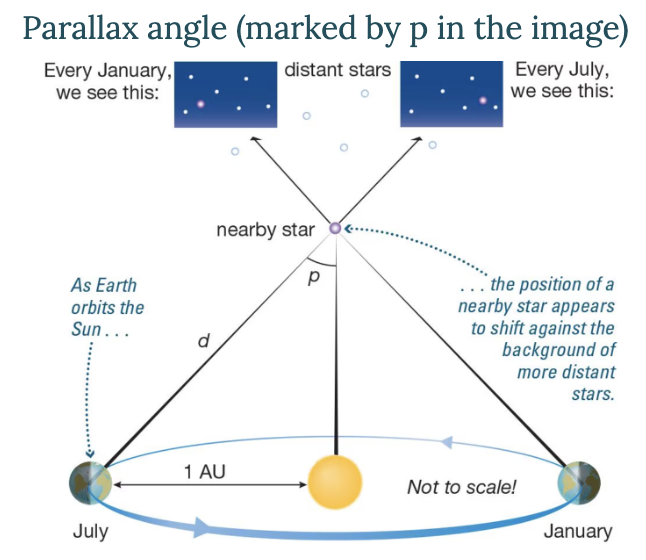
Parallax & Distance
d = distance between Earth and the star
Parallax angle and distance have an inverse relationship, so as the distance to a star increases, the parallax angle decreases
→ Imagine holding a finger close to your eye and then extending it further away. The apparent shift of your finger against the background will be smaller when it's farther away.
‘ = arcminutes
“ = arcseconds
If the star alpha centauri got farther, the parallax angle would get smaller
We can only use parallax for the closer stars
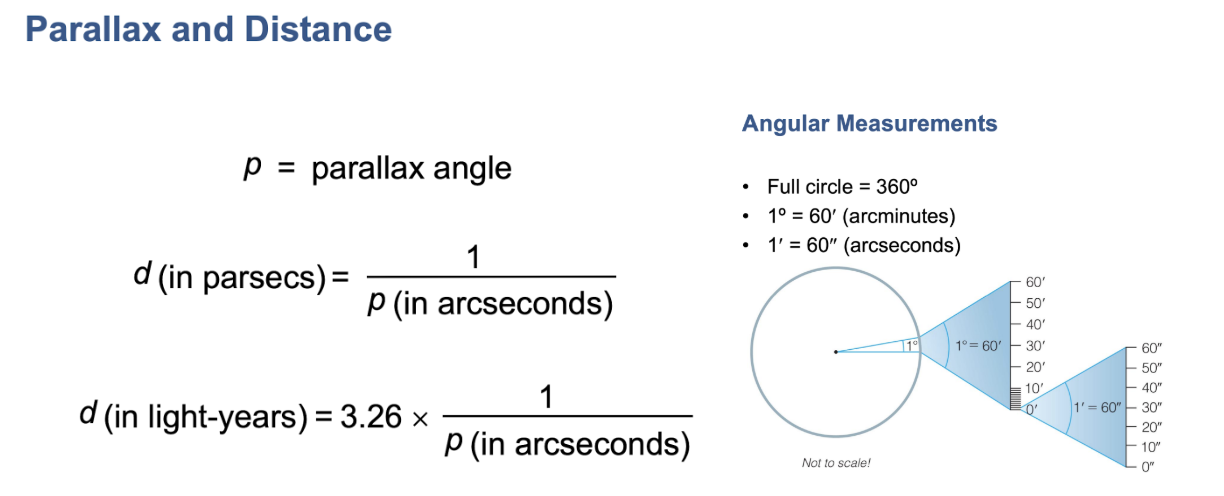
Apparent magnitude (m)
How bright a star appears in the sky (measure of brightness)
Higher magnitude actually means dimmer (big numbers = faint)
***In the Eq. star 1 is the brighter star and star 2 is the dimmer star
Counterintuitive, outdated, but standard
Mag 5 star is dimmer than a mag 0 star
Scale is logarithmic
5 magnitudes difference means a factor of 100
= 100 times brighter
Every time there’s a difference of 5 in magnitude changes by a factor of 100
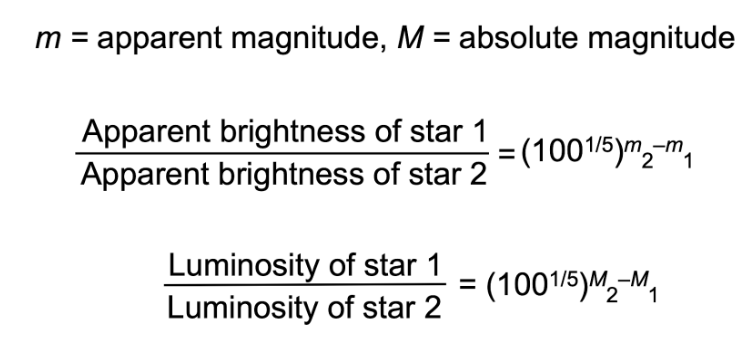
Absolute magnitude (M)
How bright a star really is in the sky
The brightness of stars if observed from a standard distance
Absolute magnitude could be used to find the luminosity
Also counterintuitive
A star with an absolute magnitude (M) of 5 corresponds to a brightness factor of 100
The range of apparent magnitude is 30 to -27, 0 being equivalent to vega
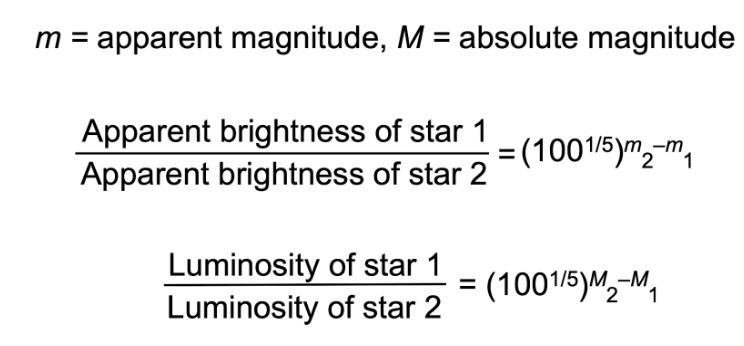
How do we measure stellar temperatures?
Every object emits thermal radiation with a spectrum that depends on its temperature
Hotter objects emit more light at all frequencies per unit area
Hotter objects emit photons with a higher average energy
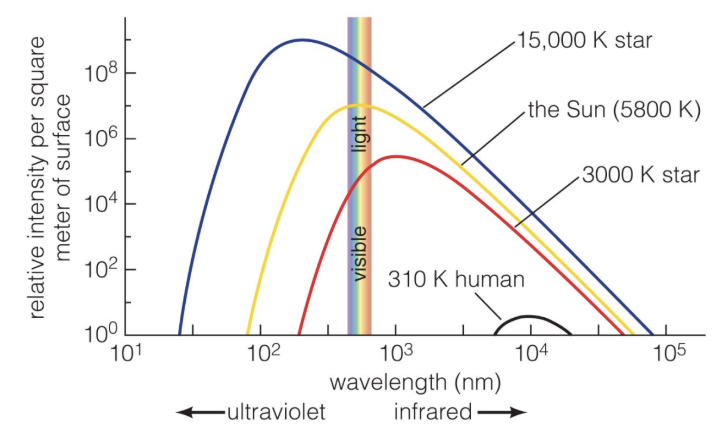
Stars & spectral types
All stars have atmospheres, the core of the stars are the “light bulbs” and the atmospheres are the “clouds”
The hottest stars have fewer absorption lines because of ionization (electrons are stripped off so they’re not jumping up energy levels)
Cooler stars have more absorption lines
Lines in a star’s spectrum correspond to a spectral type that reveals its temperature
(Each category is a spectral type)
O = hottest (less absorption) M = coolest(more absorption)
Order: O,B,A,F,G,K,M
Oh Boy, An F Grade Kills Me
Each spectral type is subdivided into numbered subcategories (such as B0, B1,…, B9). The larger the number, the cooler the star. For example, the Sun is designated spectral type G2, which means it is slightly hotter than a G3 star but cooler than a G1 star.
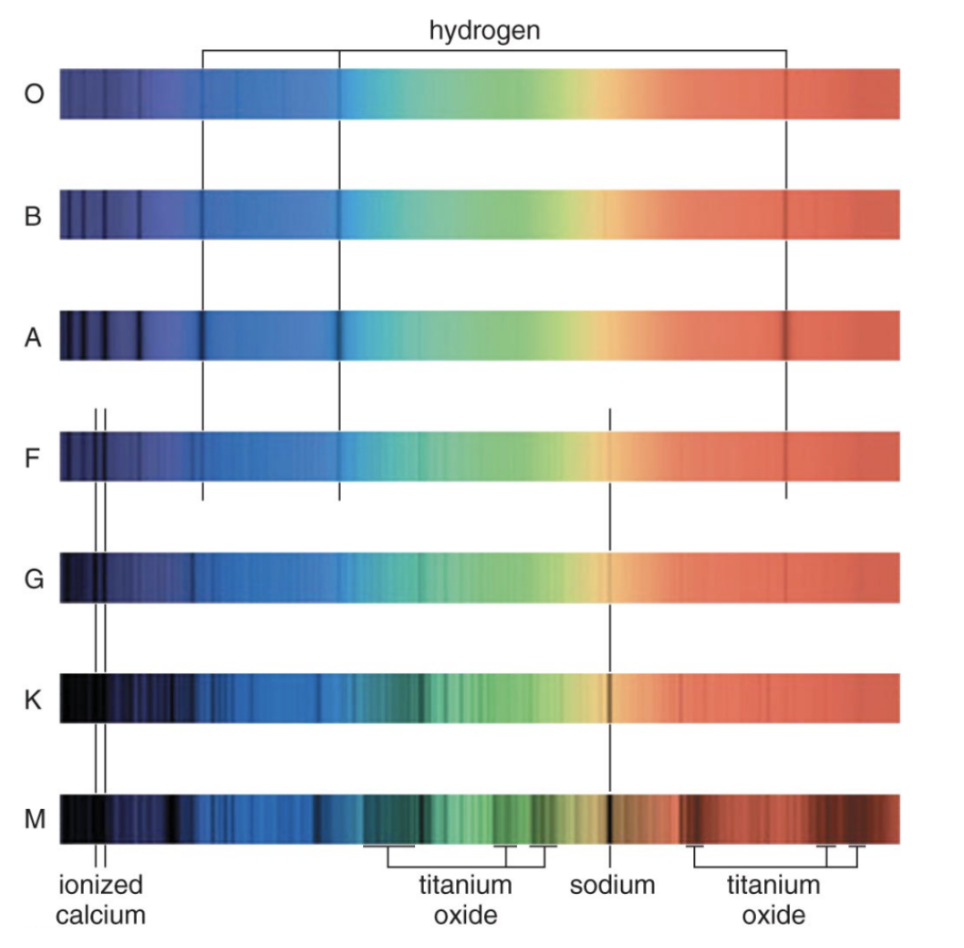
How do we measure stellar masses?
→ You have to have a binary system (two stars)
About half of all stars are in binary systems
→ You need two objects that revolve around each other and their gravitational pull on each other
Larger object = more gravitational pull, why the Earth orbits the sun
What are the three types of binary star systems:
Visual binary, spectroscopic binary, and eclipsing binary
Visual binary
We can directly observe the orbital motions of these stars
Take images and see the stars moving around each other over time
Most binary star systems appear as one star

Spectroscopic binary
We determine the orbit by measuring doppler shifts
You can see the redshifts and blueshifts of the hydrogen spectrum lines of the two stars
See how the lines change over time
From the redshift and blueshift of the star you can get velocity
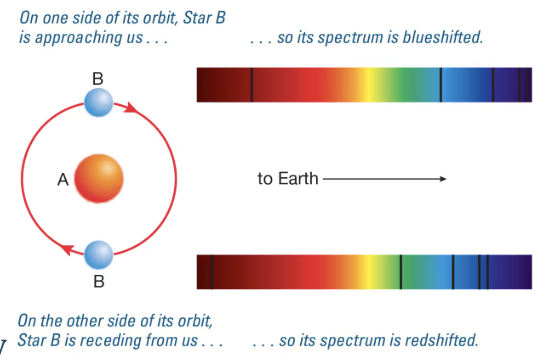
Eclipsing binary
We can measure periodic eclipses
One star goes directly in front of the other so it appears to be covering it
You take multiple images over time and see how the brightness changes as one star goes over the other
Dip = flux drop because the blue star is the hottest, its contributing the most to the flux, it depends on which one is the brighter/hotter star
When blue is in front it appears blueshifted on spectrum and red when its behind
Bigger dip = hotter star is behind
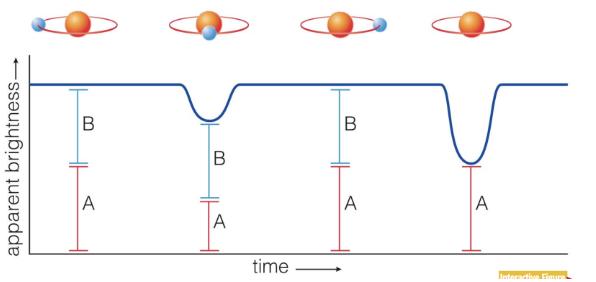
Need two out of three observables to measure mass (get the mass of a star):
Orbital period (p) ⇒ convert to years
Orbital separation (a or r = radius)
Orbital velocity (v) ⇒ hopefully in m/s so radius will be in meters, then km
For circular orbits, v = d/t → d = v*t
Recap: How do we measure stellar luminosities?
If we measure a star’s apparent brightness and distance, we can compute its luminosity with the inverse square law for light
Parallax tells us distances to the nearest stars
Recap: How do we measure stellar temperatures?
A star’s color and spectral type both reflect its temperature
Recap: How do we measure stellar masses?
Newton’s version of Kepler’s third law tells us the total mass of a binary system, if we can measure the orbital period (p) and average orbital separation of the system (a)
H-R Diagram
H-R diagram depicts:
Temperature
Color
Spectral Type
Luminosity
Radius
Higher temps to the left
Radius is related to luminosity and temperature so you can calculate it from those
Radius is increasing as we go to the top right of the diagram
Plots the luminosity and temperature of stars
If star is in the line of stars = Main sequence star, it’s burning hydrogen in its core
Most stars fall somewhere on the main sequence of the H-R diagram
Main sequence stars in the red will take the longest to burn through their hydrogen, so longer lifetime
Longest stage of a star’s life since most of them are there
Stars with lower T and higher L than main sequence stars must have a larger radius. These stars are called giants and supergiants
Stars with higher T and lower L than main sequence stars must have a smaller radius. These stars are called white dwarfs
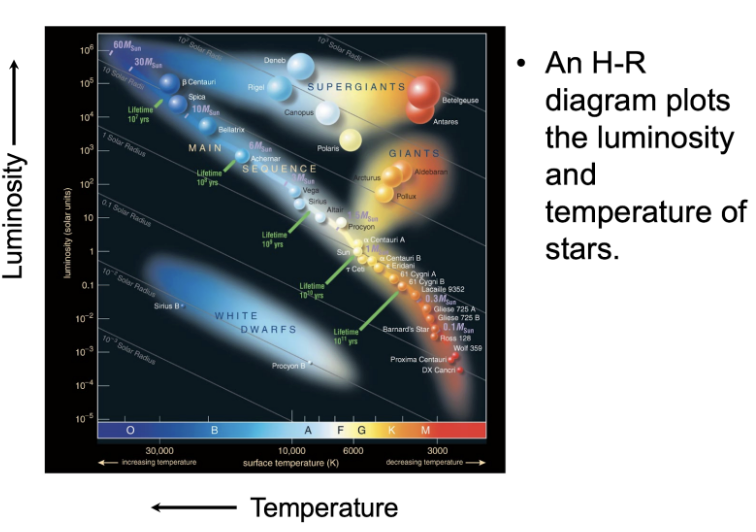
Stellar luminosity classes **Not as important
A star’s full classification includes spectral type (line identities) and luminosity class (line shapes, related to the size of the star):
I = Supergiant
II = Bright Giant
III = Giant
IV = Subgiant
V = Main Sequence
Ex. Sun = V = Main sequence
Lifetimes on the main sequence
Stellar lifetimes increase from the upper left to lower right on the main sequence: High-mass stars live shorter lives because their high luminosities mean they consume their nuclear fuel more quickly
→ Wherever they’re born, that what they gotta deal with
→ The more luminous the star, the higher the nuclear reaction rate
Hot, blue stars have more mass than cool, red stars and are more luminous
The initial mass that a star is born with dictates the rest of its life, the temperature and luminosity
What is the sun’s life expectancy? + Why
10 billion years
The life expectancy of smaller stars is longer because they burn fuel slower compared to a larger mass star
High-mass stars:
Core pressure and temperature of a higher-mass star need to be larger in order to balance gravity
→ Higher core temperature boosts fusion rate, leading to larger luminosity
High luminosity
Short-lived
Larger radius
Blue
≥ 8 Solar Masses
Undergo fusion via the CNO cycle
Low-mass star:
Low luminosity, faint
Long-lived
Small radius
Red
≤ 2 Solar Masses
Undergo fusion via the proton-proton chain
When a star moves off of the main sequence (when it stops burning hydrogen in the core):
Stellar properties depend on both mass and age: Those that have finished fusing H to He in their cores are no longer on the main sequence
All stars become larger and redder after exhausting their core hydrogen: giants and supergiants
Most stars end up small and white after fusion has ceased: white dwarfs
Variable stars
Any star that varies significantly in brightness
Some stars vary in brightness because they cannot achieve proper balance between power welling up from the core and power radiated from the surface
Such a star alternately expands and contracts, varying in brightness as it tries to find a balance
You have to be off of the main sequence because you need non-gravitational equilibrium, hydrogen fusion has stopped in the core, luminosity is constantly changing, the star’s radius is changing over time
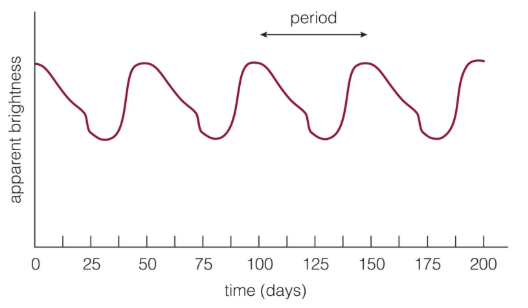
Pulsating variable star
The light curve of this pulsating variable star shows that its brightness alternatively rises and falls over a 50 day period
It always has a maximum brightness and follows the period
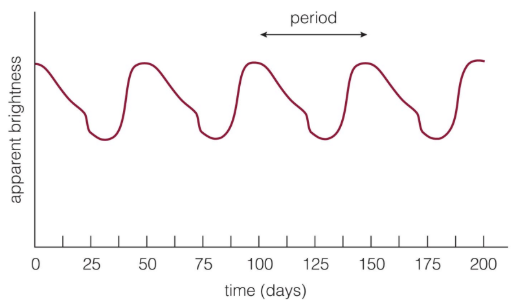
Cepheid variable stars
Type of pulsating variable star
Most pulsating variable stars inhabit an instability strip on the H-R diagram
The most luminous ones(also the biggest) are known as Cepheid variables
What’s true about star clusters?
If you have a grouping of stars (a cluster) they are likely the same age, and relatively the same difference from Earth
Star clusters have stars that were born around the same time, but with varying masses
Difference in stars’ flux depends on their masses (dictates the rest of their life since they were born with different masses), distance and age can be eliminated
Open cluster
Stars are more spread out (left image)
Found in the disc of the galaxy
Lots of blue (young) stars because it’s young - O stars
Contain up to a few thousand stars
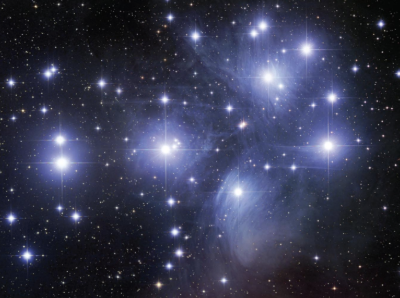
Globular cluster
Stars are more together (right image)
Up to a million or more stars in a dense ball bound together by gravity
Found in the Halo
No blue stars cuz this thing is old
They died, the blue stars/O stars have evolved off of the main sequence
Its the M stars (red stars) mostly
Oldest ones are 13 billion years old
Contains hundred of thousands of stars
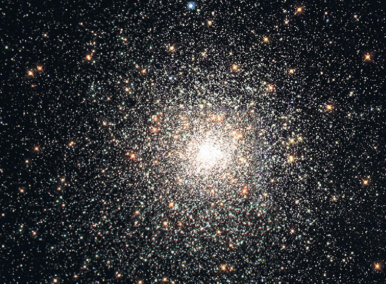
Turnoff points (main sequence)
The B stars are starting to turnoff
Turnoff = when nuclear fusion stops
The main sequence turnoff point of a cluster tells us its age
*The point where stars leave the main sequence corresponds to the age of the cluster's most massive, short-lived stars
Younger star clusters have a main-sequence turnoff point that is higher on the HR diagram, because only the most massive, hottest, and brightest stars have had time to evolve off of the main sequence, over time this could shift downwards
Older star clusters have a main-sequence turnoff point that is lower on the HR diagram
*Stars in clusters are born at the same time
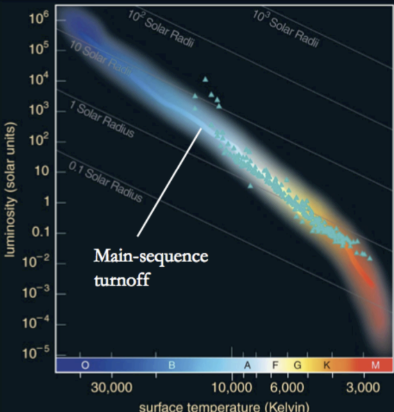
How do we measure the age of a star cluster?
A star cluster's age roughly equals the life expectancy of its most massive stars still on the main sequence/the cluster’s turnoff point
Ex. For the Pleiades, turnoff occurs around spectral type B6. The main-sequence lifetime of a B6 star is roughly 100 million years, so this must be the age of the Pleiades
Purple one is younger than teal cluster
HR diagrams show us the age
Our galaxy isn’t old enough for any cluster to have an M star evolve off
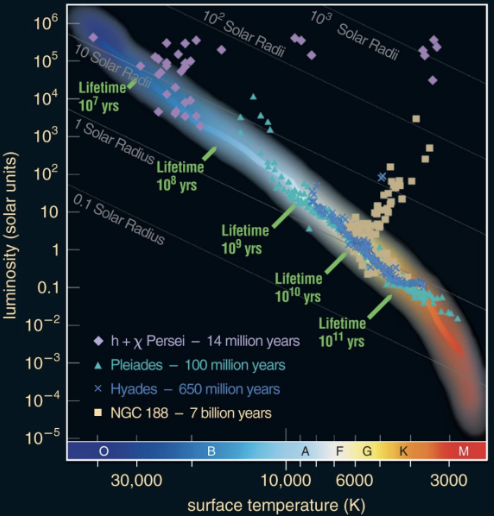
Where do stars form
Stars form in dark clouds of dusty gas in interstellar space
The gas found between stars is called the interstellar medium (ISM)
Certain parts are more dense than others, that’s where the molecular clouds are
→ You can only have this with colder temperatures (molecules together)
Molecular clouds have higher densities, lower temperatures than the interstellar medium that they are in
Composition of clouds
We can determine the composition of interstellar gas from its absorption lines in the spectra of stars
By looking at the absorption lines we can see the composition of the clouds
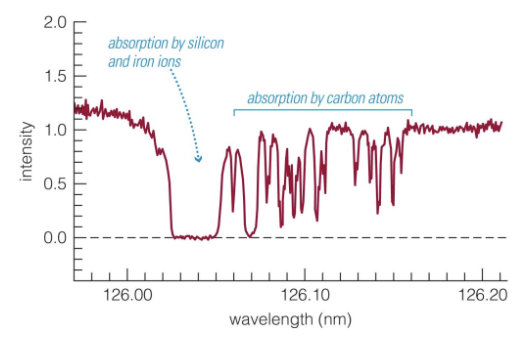
Molecular clouds
Most of the matter in star-forming clouds is in the form of molecules
They are made of mostly hydrogen, by stay cool because of emission by carbon monoxide
These molecular clouds have a temperature of 10-30K (low temperature) and a high density, which is what you need to form stars, you need a lot of cool material in one place to collapse on itself and not move around
Low temp + high density, high mass
Most of what we know about molecular clouds comes from observing the emission lines of carbon monoxide
Interstellar dust
Tiny solid particles of interstellar dust block our view of stars on the other side of a cloud
Particles are <1 micrometer in size and made of elements like C, O, Si and Fe
Dust particles/grains are absorbing and scattering light
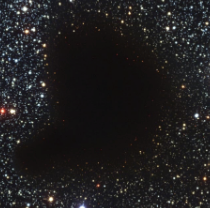
Interstellar reddening
Interstellar reddening occurs for much the same reason that our Sun appears redder when viewed through smoke or smog
→ Stars viewed through the edges of the cloud look redder because dust blocks (shorter-wavelength) blue light more effectively than (longer-wavelength) red light
→ The dust scatters light to longer wavelengths, that's why the edges appear redder
Long-wavelength infrared light passes through a cloud more easily than visible light because dust cannot block infrared light(long wavelengths) very well
Observations of this infrared light reveal stars on the other side of the cloud
As a star first begins to condense, it emits primarily in the infrared (longer wavelengths) because its small and low temp
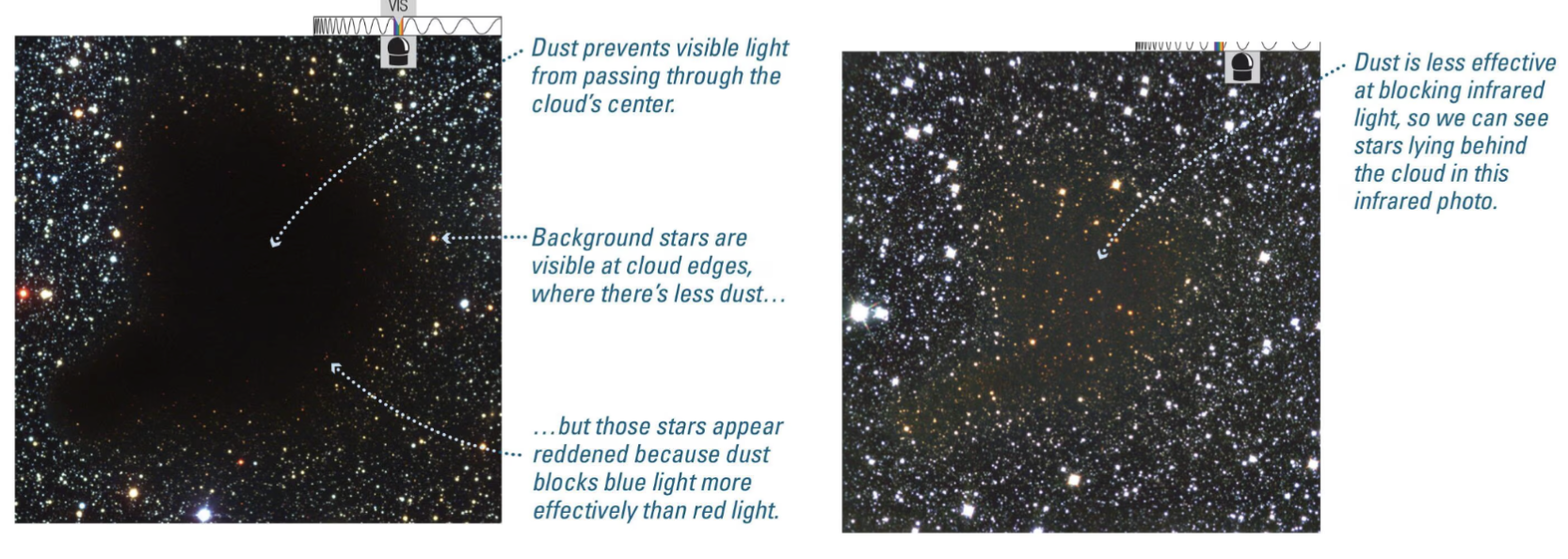
Observing newborn stars
Visible light from a newborn star is often trapped within the dark, dusty gas clouds where the star formed
Observing the infrared light from a cloud can reveal the newborn star embedded inside it
Glowing dust grains
Dust grains that absorb visible light heat up and emit infrared light of an even longer wavelength
Long-wavelength infrared light is brightest from regions where many stars are currently forming → because dust
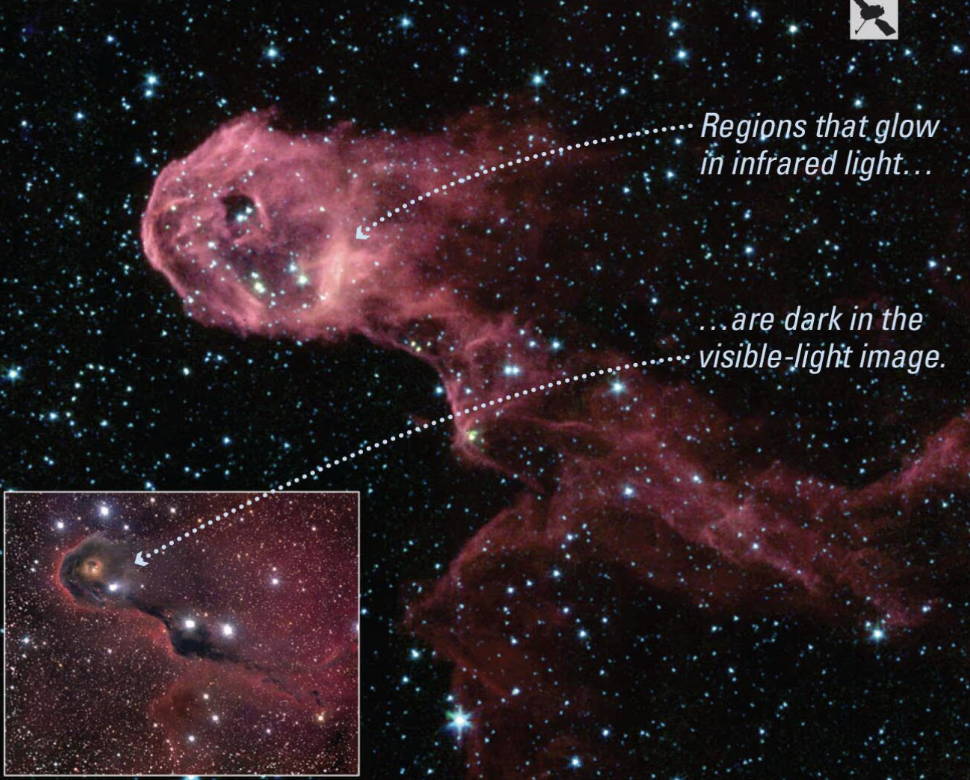
Why do stars form?
Gravity can create stars only if it can overcome the outwards push/force of thermal pressure in a cloud, the clump of material (molecular cloud)
Emission lines from molecules in a cloud can prevent a pressure buildup by converting thermal energy into infrared and radio photons, energy is being released, (infrared & radio portions of spectrum) the cloud’s temperature can be cold now, which weakens the thermal pressure, so now all the cool parts of the cloud can contract to form stars
A typical molecular cloud must contain at least a few hundred solar masses for gravity to overcome pressure - Gravity and mass are like &
Resistance to gravity
SO BASICALLY GRAVITY DEPENDS ON MASS ⇒ THATS WHY STARS TEND TO FORM IN CLUSTERS, BECAUSE GRAVITY IS STRONGER IN A HIGH-MASS CLOUD
A cloud must have even more mass to begin contracting if there are additional forces opposing gravity
Both magnetic fields and turbulent gas motions increase resistance to gravity
Both magnetic fields and temperature oppose gravity, so gravity has to win for star formation
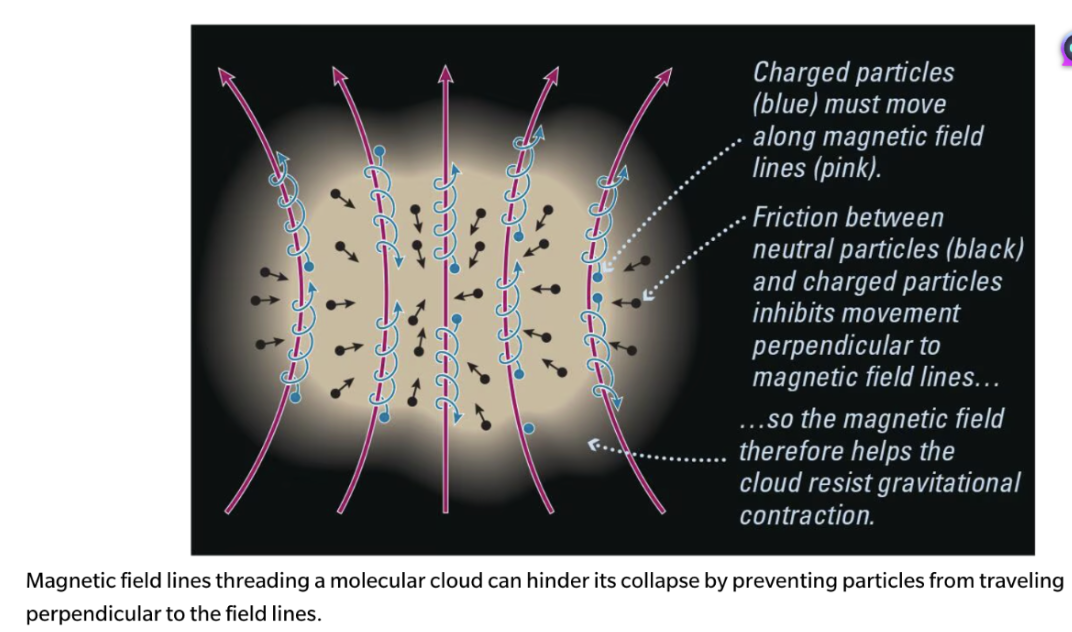
Fragmentation of a cloud
Gravity within a contracting gas cloud becomes stronger as the gas becomes denser
Gravity can therefore overcome pressure in smaller pieces of the cloud, causing it to break apart into multiple fragments, each of which may go on to form a star → a large cloud can make a whole cluster of stars
A gas cloud must have a mass greater than its Jeans mass for gravity to overcome internal pressure and cause it to collapse and form a star.
Isolated star formation
Gravity can overcome pressure in a relatively small cloud if the cloud is unusually dense
Such a cloud may make only a single star
The first stars
Elements like carbon and oxygen had not yet been made when the first stars formed, they could’ve only been made of hydrogen and helium they were the most massive :)))
Without CO molecules to provide cooling, the clouds that formed the first stars had to be considerably warmer than today’s molecular clouds
The first stars must therefore have been more massive than most of today's stars, for gravity to overcome pressure
Recap: Where do stars form?
– Stars form in dark, dusty clouds of molecular gas with temperatures of 10–30 K.
– These clouds are made mostly of molecular hydrogen (H2) but stay cool because of emission by carbon monoxide (CO).
Recap: Why do stars form?
– Stars form in clouds that are massive enough for gravity to overcome thermal pressure (and any other forms of resistance). A gas cloud must have a mass greater than its Jeans mass for gravity to overcome internal pressure and cause it to collapse and form a star.
– Such a cloud contracts and breaks up into pieces that go on to form stars.
What slows the contraction of a star-forming cloud?
Trapping of thermal energy (heat in the gas)
The magnetic field of the cloud exerts an outwards force/pressure on the gas and dust particles, against gravity
The rotation of the cloud makes an outwards centrifugal force (salad spinner)
As contraction packs the molecules and dust particles of a cloud fragment closer together, it becomes harder for infrared and radio photons to escape.
Thermal energy then begins to build up inside, the temperature and pressure begin to rise, which pushes back against gravity, and slows the contraction.
Contraction slows down, and the center of the cloud fragment becomes a protostar, but not yet a true star because their cores are not hot enough to burn hydrogen in the core (no nuclear fusion
Growth of a protostar
Matter from the cloud continues to fall onto the protostar until either the protostar or a neighboring star blows the surrounding gas away
The protostar has wind that pushes gas and dust away
What is the role of rotation in star birth?
The nebular theory of solar system formation illustrates the importance of rotation
The rotation speed of the cloud from which a star forms increases as the cloud contracts (the clouds rotation must increase as it shrinks in size according to the law of angular momentum)
When an object is spinning, it has to maintain angular momentum
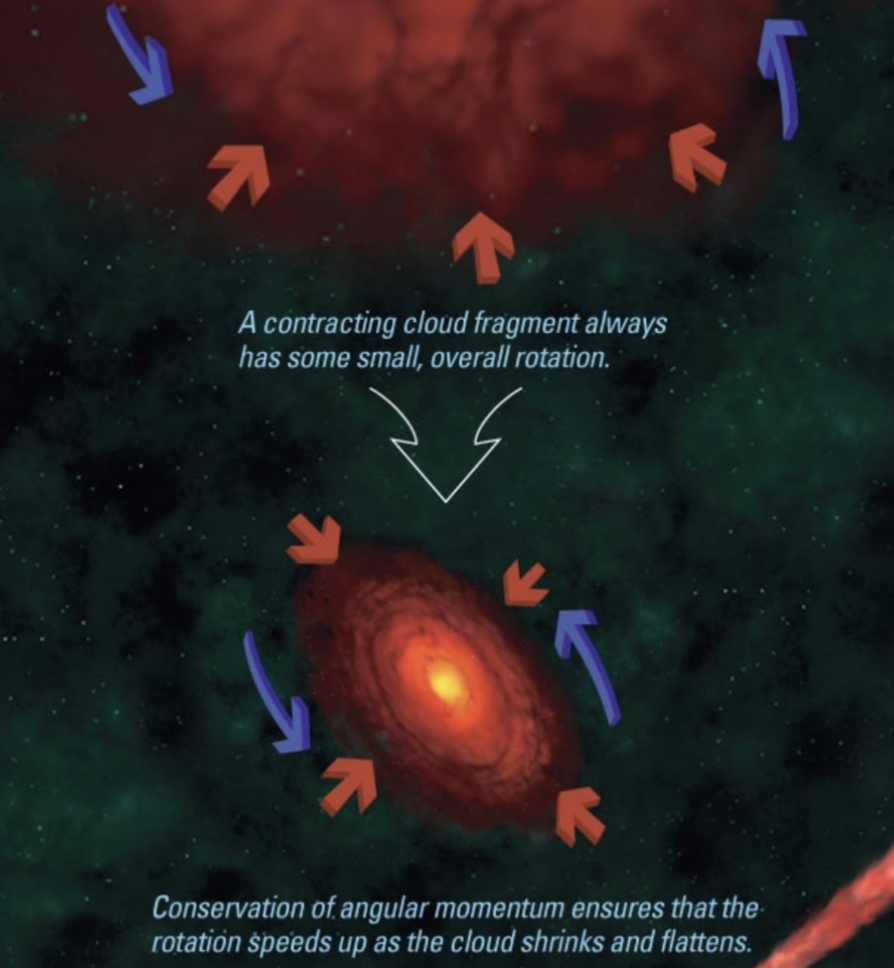
Angular momentum
Large mass: Big radius small velocity → as a protostar collapses (small mass) it has a small radius so it has to compensate with a greater velocity
Mvr = Angular momentum
→ is conserved
If radius goes down, velocity has to go up to maintain a constant angular momentum
→ Like an ice skater with arms out and in to spin faster
Flattening
Collisions between particles in the cloud cause it to flatten into a disk
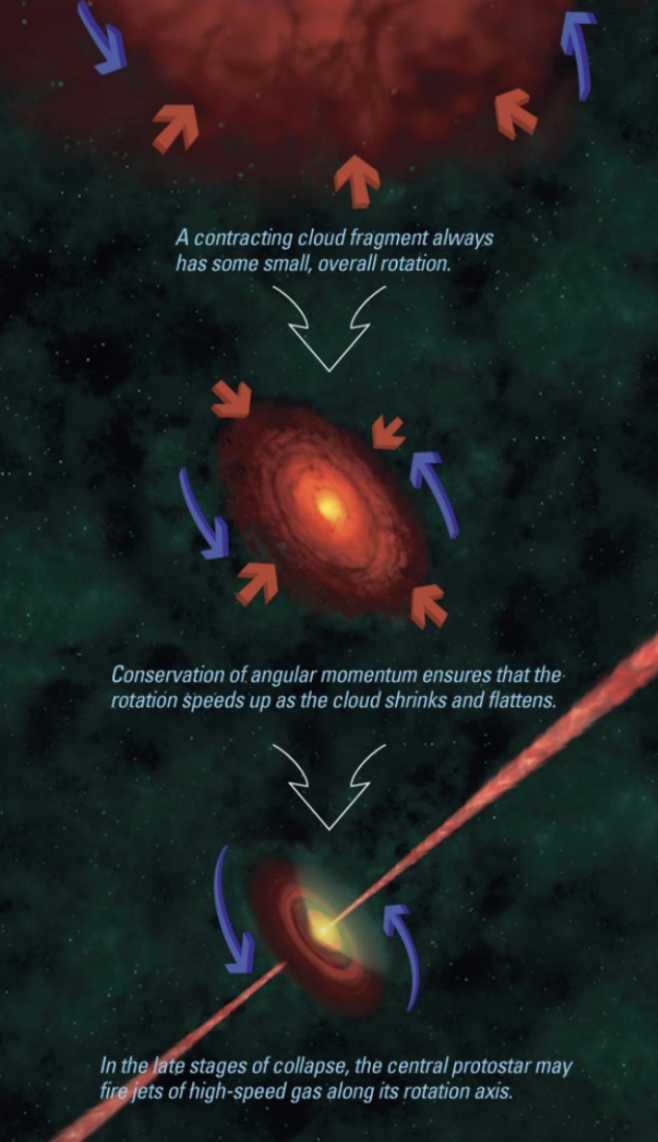
Formation of jets
Rotation also causes jets of matter to shoot out along the rotation axis
Most of the material comes out from the center in jets, for protostars
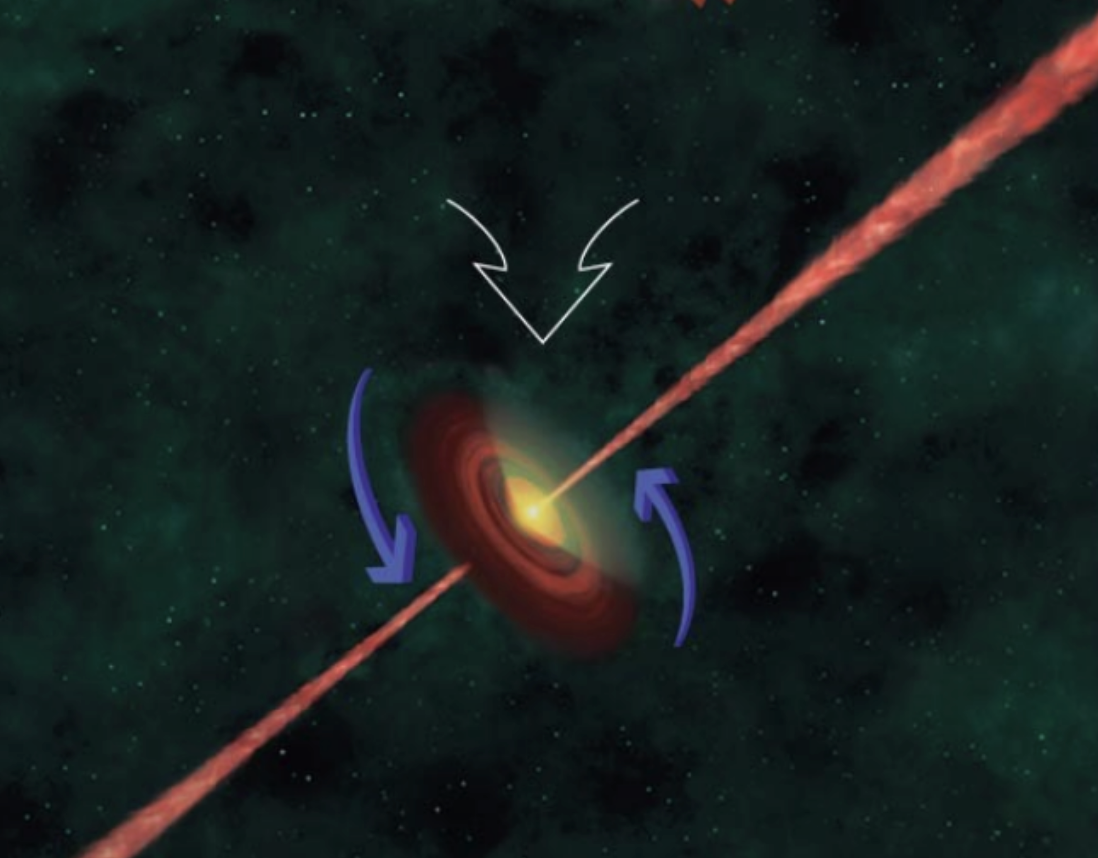
From protostar to main sequence
A protostar looks starlike after the surrounding gas is blown away, but its thermal energy comes from gravitational contraction, not fusion
Contraction must continue until the core becomes hot enough for nuclear fusion
Contraction stops when the energy released by core fusion balances energy radiated from the surface—the star is now a main-sequence star
Essentially, protostars are slowly contracting over time until the point where nuclear fusion starts
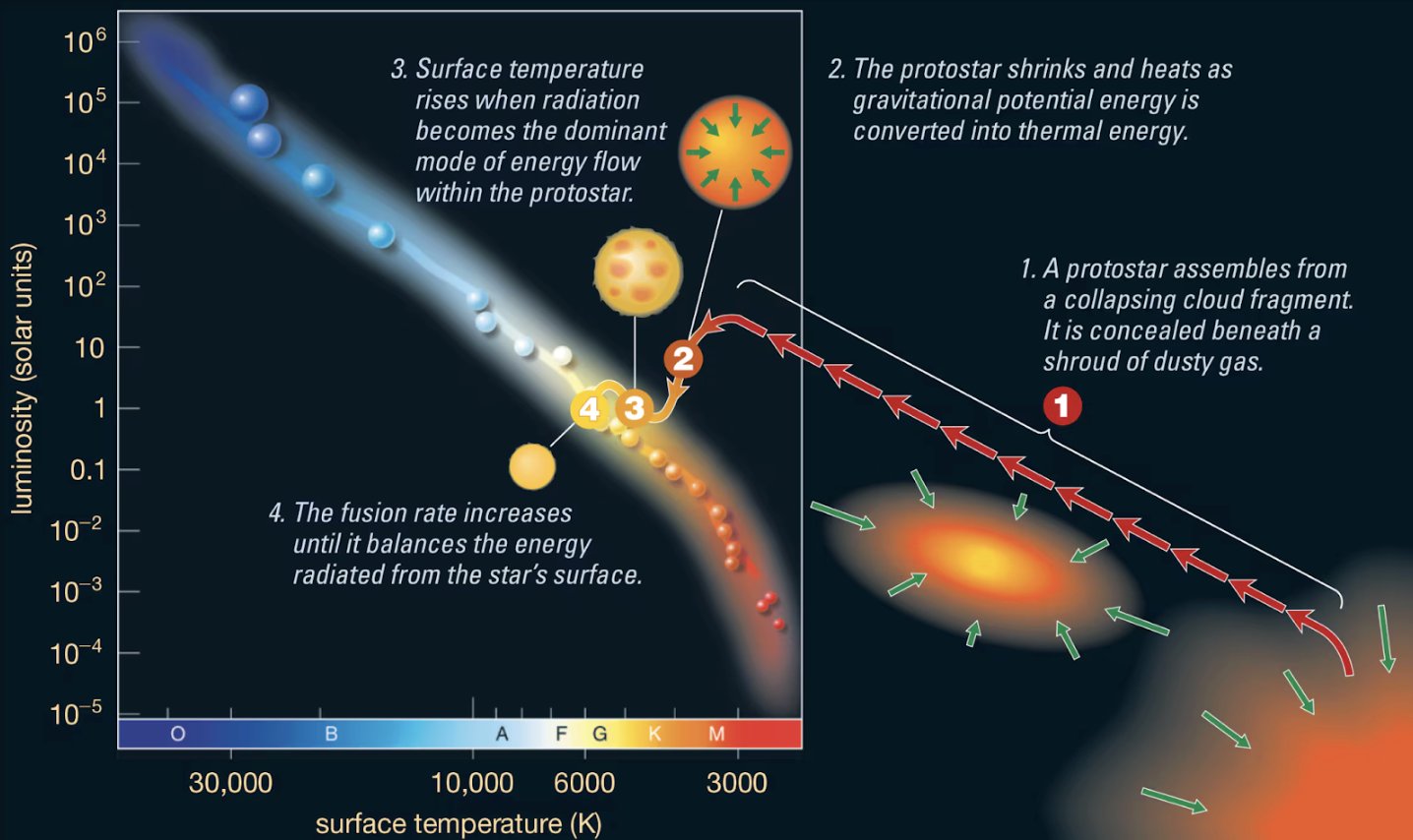
Protostar → Main sequence TIME
The length of time from the formation of a protostar to the birth of a main-sequence star depends on the star’s mass. Massive stars do everything faster. The contraction of a high-mass protostar into a main-sequence star of spectral type O or B takes less than a million years. Lower mass stars form more slowly
→ Protostars of different masses go through similar stages as they approach the main sequence, but they progress through those stages at different rates
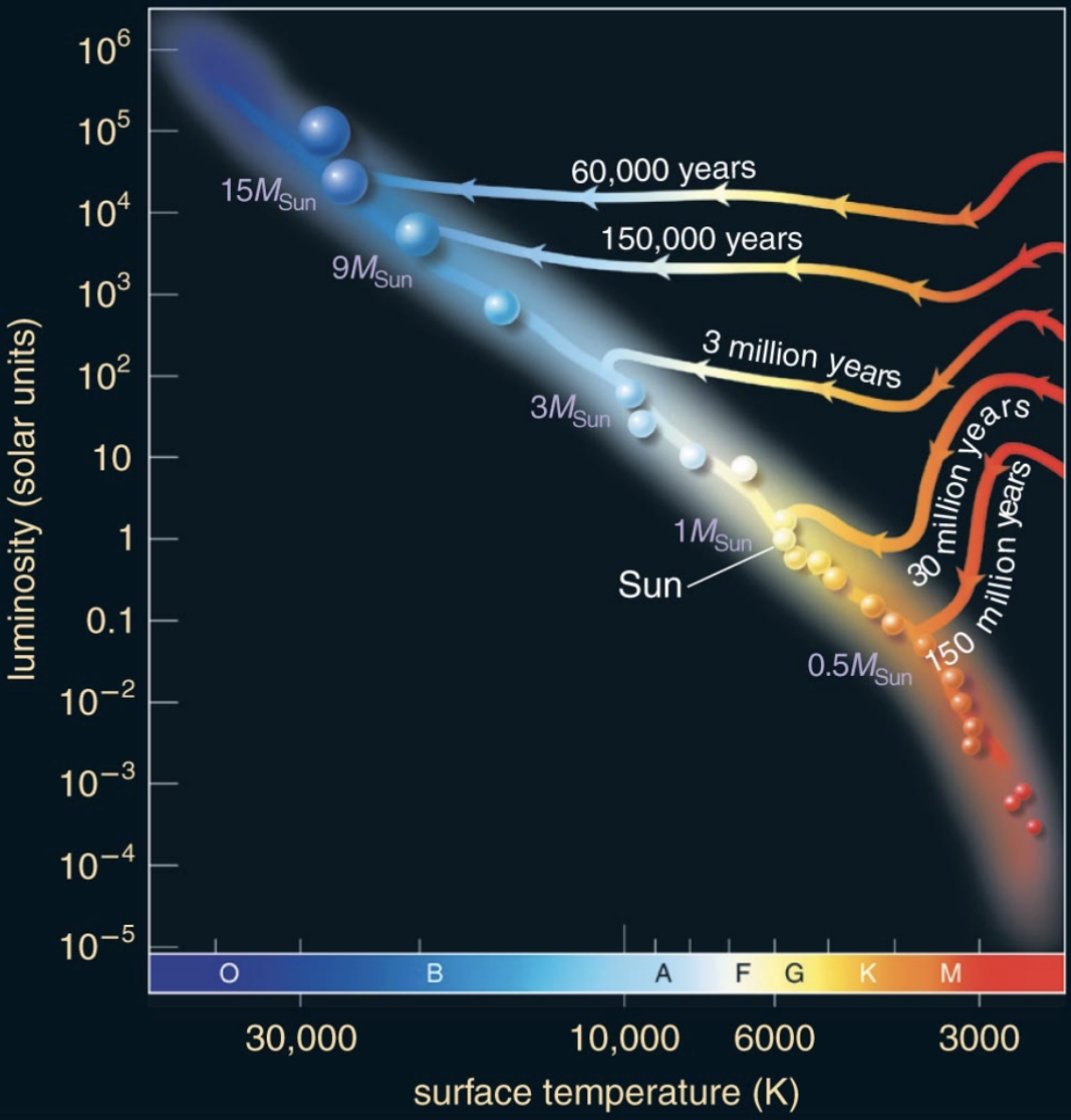
What is the smallest mass a newborn star can have? (Brown Dwarf)
It has to be on the main sequence (nuclear fusion) to be called a star.
A brown dwarf = a small mass contracting object that will never reach the temperature in its core to have nuclear fusion
→ It doesn’t collapse on itself because of degeneracy pressure
Fusion will not begin in a contracting cloud if some sort of force stops contraction before the core temperature rises above 107 K.
Thermal pressure cannot stop contraction because the star is constantly losing thermal energy from its surface through radiation.
Degeneracy pressure can stop contraction
→ For some objects, like a brown dwarf, degeneracy pressure will kick in before the core can become hot enough for nuclear fusion
A brown dwarf emits infrared light because of heat left over from contraction
Its luminosity gradually declines with time as it loses thermal energy
Gets dimmer with time as thermal energy cools
Degeneracy pressure
Based on mass/density
Particles can’t be in the same place
Doesn’t depend on heat content
The laws of quantum mechanics prohibit two electrons from occupying the same state in the same place
When the object (the smaller ones usually because they have a smaller “auditorium” with less seats- has contracted to a point where the electrons are so tightly together that they can’t be tighter together because all “seats” are full, pressure releases
The more mass a star has, the more “seats” it will have, so they will reach a high enough temperature before degeneracy pressure can kick in
The lower mass, the less “seats”
Thermal pressure
Based on temperature
Depends on heat content
Is the main form of pressure in most stars
Degeneracy pressure & mass
Degeneracy pressure halts the contraction of objects with < 0.08MSun → anything below 0.08 is a dwarf, anything above is a star before core temperature becomes hot enough for fusion
Starlike objects not massive enough to start fusion are brown dwarfs.
What is the greatest mass a newborn star can have?
100-200 solar masses maximum
Photons exert a slight amount of pressure when they strike matter because they have both energy and momentum
Very massive stars are so luminous that the collective pressure of photons drives their matter into space
More mass = higher temp
What are the typical masses of newborn stars?
Observations of star clusters show that star formation makes many more low-mass stars than high-mass stars.
Because it's easier to make smaller things than bigger things in molecular clouds
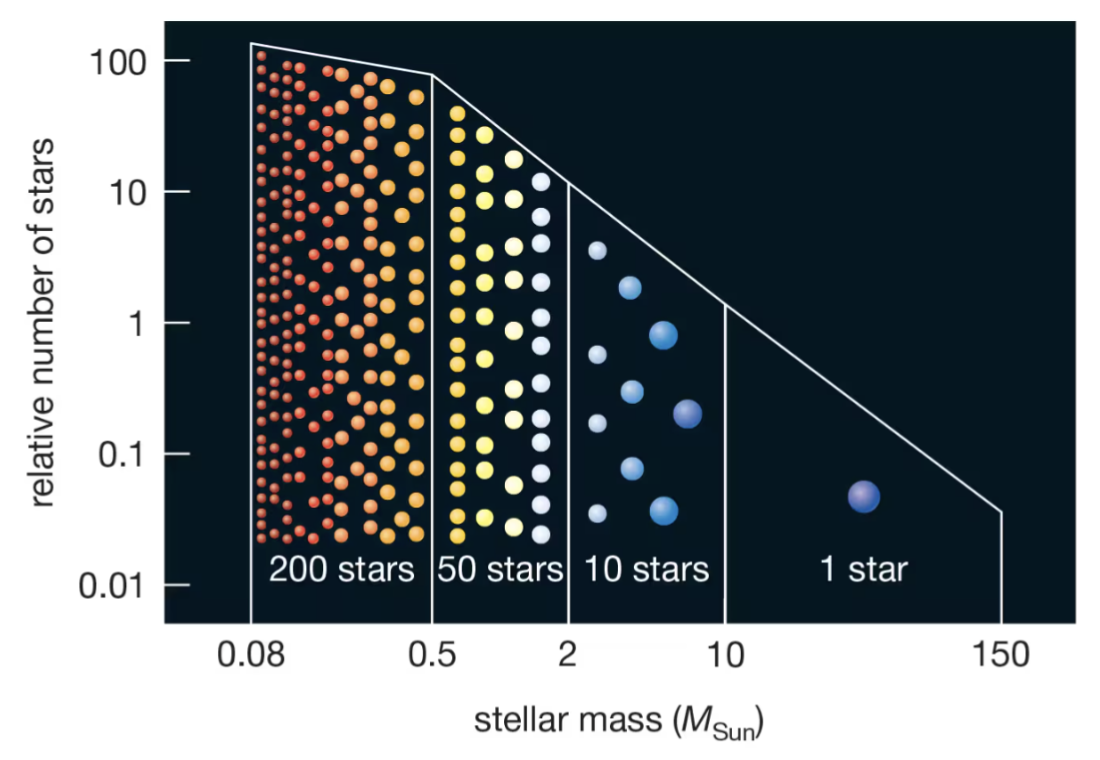
How does a star’s mass affect nuclear fusion?
The mass of a main-sequence star determines its core pressure and temperature.
Stars of higher mass have higher core temperature and more rapid fusion, making those stars both more luminous and shorter-lived.
Stars of lower mass have cooler cores and slower fusion rates, giving them smaller luminosities and longer lifetimes.
Low mass stars are 2 solar masses or less, and high-mass stars are 8 or more solar masses, intermediate mass stars are in between, brown dwarfs are super small
A star's mass determines its core pressure and temperature and therefore determines its fusion rate.
Higher mass stars have hotter cores, faster fusion rates, greater luminosities, and shorter lifetimes.
Life stages of a low-mass star
1. Protostar surrounded by a protoplanetary disk.
2. Main sequence: H fuses to He in core.
3. Red giant: H fuses to He in shell around He core.
4. Helium core burning: He fuses to C in core while H fuses to He in shell.
5. Double shell burning: H and He both fuse in shells.
6. Planetary nebula leaves white dwarf behind.
Low mass star: Stage 1 - Protostar phase
Protostar with a planetary disk
Object is contracting
Contraction must continue until the core becomes hot enough for nuclear fusion
Contraction stops when the energy released by core fusion balances energy radiated from the surface—the star is now a main-sequence star
Essentially, protostars are slowly contracting over time until the point where nuclear fusion starts
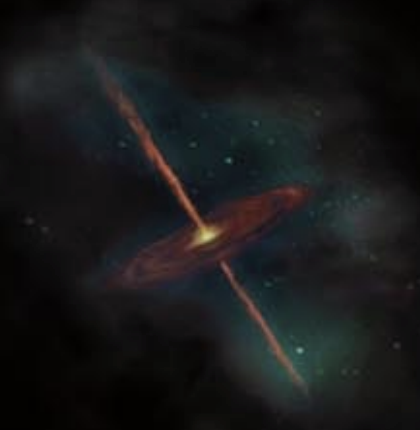
Low mass star: Stage 2 - Yellow main sequence star
Energy released and gravitational equilibrium are now balanced
Once fusion starts
Hydrogen is fusing into helium
Proton-proton chain = hydrogen nuclear fusion
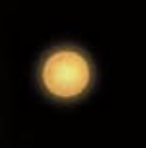
Low mass star: Stage 3 - Red giant star
When there is no more hydrogen left in the core
Once hydrogen fusion stops in the core, the star gets off the main sequence
Once a star leaves the main sequence, it can no longer do the solar thermostat thing
So the core shrinks and heats, and contains helium because it's the product of fusion
Because gravity shrinks both the helium core and then surrounding shell of hydrogen (makes it hotter), hydrogen shell begins hydrogen shell fusion around the inert(non-fusing) helium core
Fusion is happening in the hydrogen shell, which is thinner than the core, so there is a higher nuclear reaction rate so the radius inflates due to this increased energy output
Luminosity increases because the core thermostat is broken— the increasing fusion rate in the shell does not stop the core from contracting
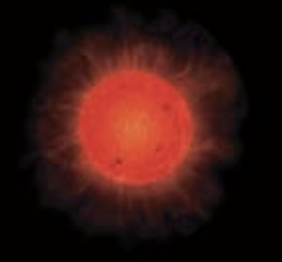
Low mass star: Stage 4 - Helium-burning star
Helium fusion does not begin right away because it requires higher temperatures than hydrogen fusion because larger charge leads to greater repulsion
Point where the helium core burning starts (helium burning) → marks the beginning of the core helium burning star (helium burning star and helium burning supergiant) for high and low mass
Helium fusion begins when the core becomes hot enough to fuse helium into carbon
Helium flash
The thermostat of a low-mass red giant is broken because (electron) degeneracy pressure supports the core against gravity
Core temperature rises rapidly when helium fusion begins
Helium fusion rate skyrockets until thermal pressure takes over and expands the core again
The core expands, slowing the rate of hydrogen shell burning and allowing the star’s outer layers to shrink
Helium-burning stars neither shrink nor grow because core thermostat is temporarily fixed
→ Helium fusion occurs, turns into carbon, now there's an inert carbon core, on top of which there is a helium shell and on top of that there's the hydrogen shell converting to helium
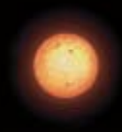
Low mass star: Stage 5 - Double-shell burning giant
After the helium in the core is exhausted, the star will expand again, just like it did in the red giant phase because this time helium fusion will happen in the shell around the core, causing a higher nuclear reaction rate and thus the radius inflates
Hydrogen fusion will continue in the shell atop the helium layer
The star then enters its second red giant phase, with fusion in both a hydrogen shell and a helium shell
Both shells will contract along with the inert core, making the fusion rates and temperatures so high that the star will be HUGE
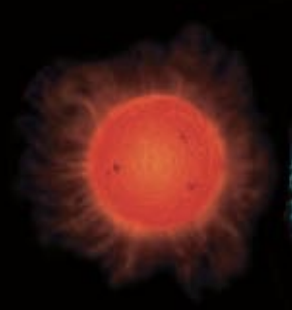
Low mass star: Stage 6 - Planetary nebula
The only place where hydrogen fusion is stable is in the core, everywhere else it's not. So like in the shell it’s unstable, so it’s short lived.
So all this fusion eventually ends, including the carbon core
The star has a weak grip on its outer layers
The outer layers are ejected into space, creating a huge shell of gas expanding away from the now exposed carbon core
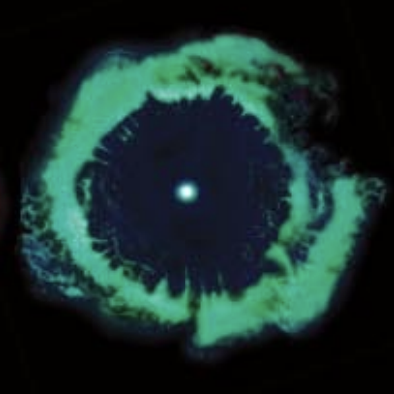
Low mass star: Stage 7 - White dwarf
As the exposed carbon cools and the ejected gas (H and He) disperses into space
All that's left in the core is carbon and oxygen = white dwarf
Fusion progresses no further in a low-mass star because the core temperature never grows hot enough for fusion of heavier elements (some helium fuses to carbon to make oxygen)
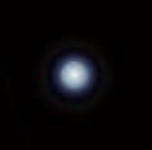
H-R Diagram + Low mass star formation
Whenever you have fusion in the core, there’s some stability that is obtained, enough time for gravitational equilibrium to happen
When there aren't a lot of objects in an area of the HR diagram, it's a short period of evolution, like a helium flash
*All of this is happening at the upper right of the HR diagram, after which they don’t go back to main sequence
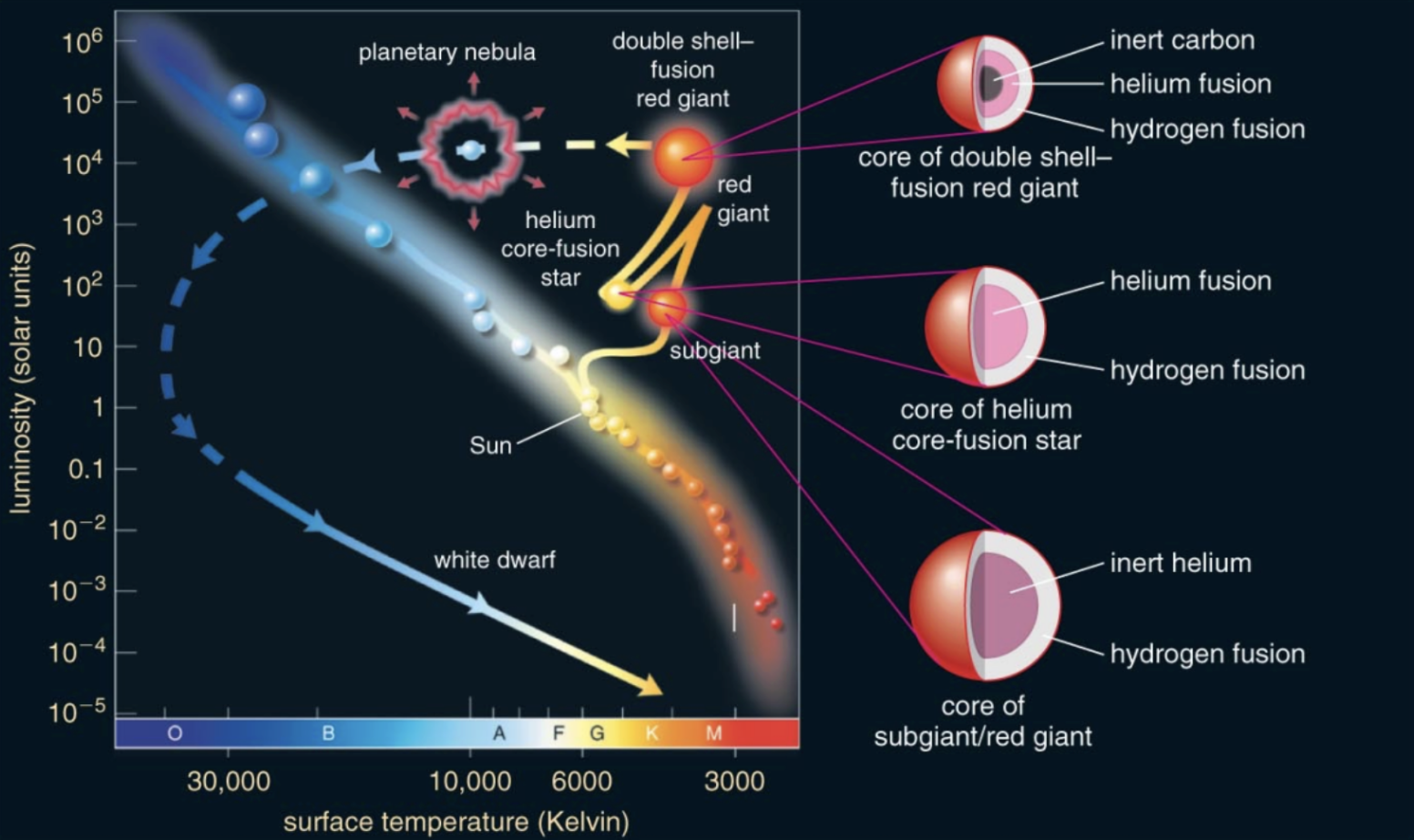
End of fusion for low mass stars
The temperature you need for the next level of fusion keeps increasing (Hydrogen = 13mil, 100mil for helium and 500mil for carbon for ex.)
Hydrogen = 13million
**The objects that aren’t supported by electron degeneracy pressure against gravity and the ones that are (white&brown dwarfs)
The sun’s luminosity increases because the composition in the core changes (Hydrogen and helium burning)
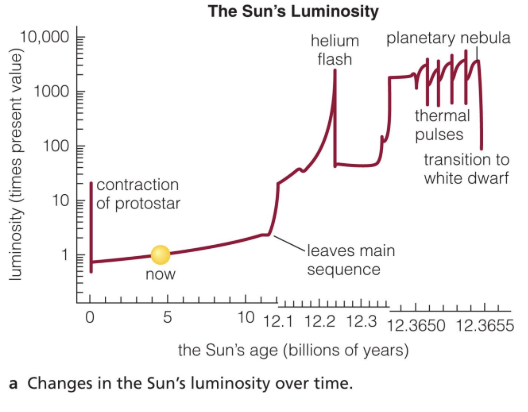
Life stages of a high-mass star
1. Protostar surrounded by a protoplanetary disk.
2. Main sequence: H fuses to He in core.
3. Red supergiant: H fuses to He in shell around He core.
4. Helium core burning: He fuses to C in core while H fuses to He in shell.
5. Multiple shell burning: Many elements fuse in shells.
6. Supernova leaves neutron star or black hole behind
High mass star: Stage 1 - Protostar
Protostar with a planetary disk
Object is contracting
Contraction must continue until the core becomes hot enough for nuclear fusion
Contraction stops when the energy released by core fusion balances energy radiated from the surface—the star is now a main-sequence star
Essentially, protostars are slowly contracting over time until the point where nuclear fusion starts
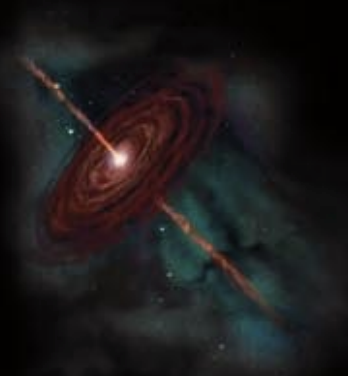
High mass star: Stage 2 - Blue main-sequence star
Longest stage of a star’s lifetime
In the core of a high mass star, four hydrogen fuse to one helium by a series of reactions known as the CNO cycle

High mass star: Stage 3 - Red supergiant
After core hydrogen is exhausted, the core shrinks and heats, Hydrogen shell burning begins around the inert helium core, causing the star to expand into a red supergiant
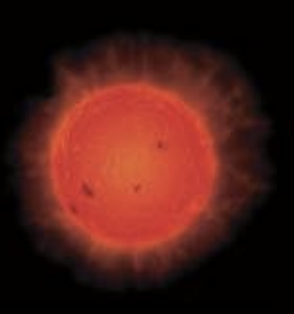
High mass star: Stage 4 - Helium-burning supergiant
Helium fusion begins when the core temperature becomes hot enough to fuse helium into carbon
The core then expands, slowing the rate of hydrogen shell burning and allowing the star’s outer layers to shrink
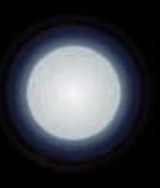
High mass star: Stage 5 - Multiple shell-burning supergiant
After the core runs out of helium, it shrinks and heats until fusion of heavier elements begins
Late in life, the star fuses many different elements in a series of shells while iron collects in the core
It can’t fuse iron, that's its stopping point on the periodic table, so it has an iron core now
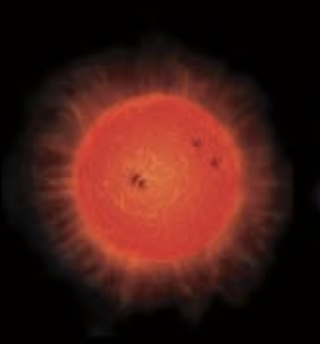
High mass star: Stage 6 - Supernova
Iron core
Iron can’t provide fusion energy, so it accumulates in the core until degeneracy pressure can no longer support it
Then the core collapses, leading to the catastrophic explosion of the star
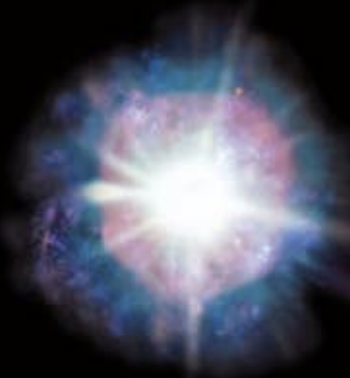
High mass star: Stage 7 - Neutron star or black hole
The core collapse forms a ball of neurons, which may remain as a neutron star or collapse further to make a black hole

Black holes & Neutron stars - who becomes what?
Black holes (the higher of the high-mass stars become these) and neutron stars (the lower of the high-mass stars become these)
CNO Cycle
High-mass main-sequence stars fuse H to He at a higher rate using carbon, nitrogen, and oxygen as catalysts for the reaction to go faster
Greater core temperature enables hydrogen nuclei to overcome greater repulsion
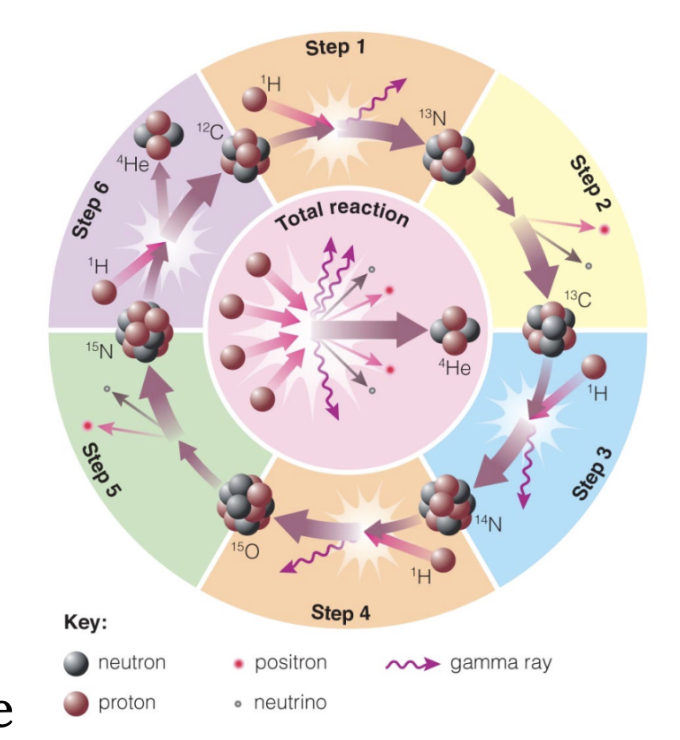
How do high-mass stars make elements for life
Big bang only made H and He, stars made everything else
Helium fusion can’t make carbon in low-mass stars
But the CNO cycle can change carbon into nitrogen and oxygen
Low mass stars burn up to carbon and high-mass stars up to iron. The high-mass stars that went supernova provided the other elements.
Helium capture
High core temperatures allow helium to fuse with heavier elements like carbon, oxygen, and nitrogen to form the other elements
Advanced nuclear burning
Allows the rest of the elements (Si, S, Ca, Fe) up till iron to be formed
Core temperatures in stars with >8MSun allow fusion of elements as heavy as iron
Iron is a dead end for fusion because nuclear reactions involving iron do not release energy (This is because iron has the lowest mass per nuclear particle.)
It takes more energy to fuse iron than it produces that's why it’s the last stop
How many shells in low mass vs. high mass stars?
Low mass shells only have two shells, one for hydrogen to helium and one from helium to carbon
High mass shells have more shells than the low mass stars
How does a high mass star die?
Explosion (supernova): Iron is going to keep building up in the core (cuz heavier element so it sinks to the core) but then the degeneracy pressure cannot support the core anymore against gravity so it suddenly collapses, and mass keeps being added up and that core condenses down to really tiny and the upper layers come crashing down and then everything explodes.
The neutrons collapse to the center which forms a neutron star because the electrons (the seat filling) combine with protons to form neutrons
Energy and neutrons released in supernova explosion
Energy released by the collapse of the core drives the star’s outer layers into space.
The roles of mass and a star’s life
A star's mass determines its entire life story because it determines its core temperature.
High-mass stars with > 8MSun have short lives, eventually becoming hot enough to make iron, and end in supernova explosions.
Low-mass stars with < 2MSun have long lives, never become hot enough to fuse carbon nuclei, and end as white dwarfs.
Intermediate-mass stars can make elements heavier than carbon but end as white dwarfs.
Mass exchange
When the more massive star begins to expand into a red giant, gas from its outer layers can spill onto its companion
This happens when the red giant grows so large that it succumbs to the gravitational attraction of the smaller companion star
The companion then begins to gain mass from the giant
In other words → The 0.8Msun subgiant (the 0.8Msun one) used to be much more massive, and it was the first to begin expanding into a red giant, but as it expanded, it transferred so much of its mass to its companion that it is now the less massive star.
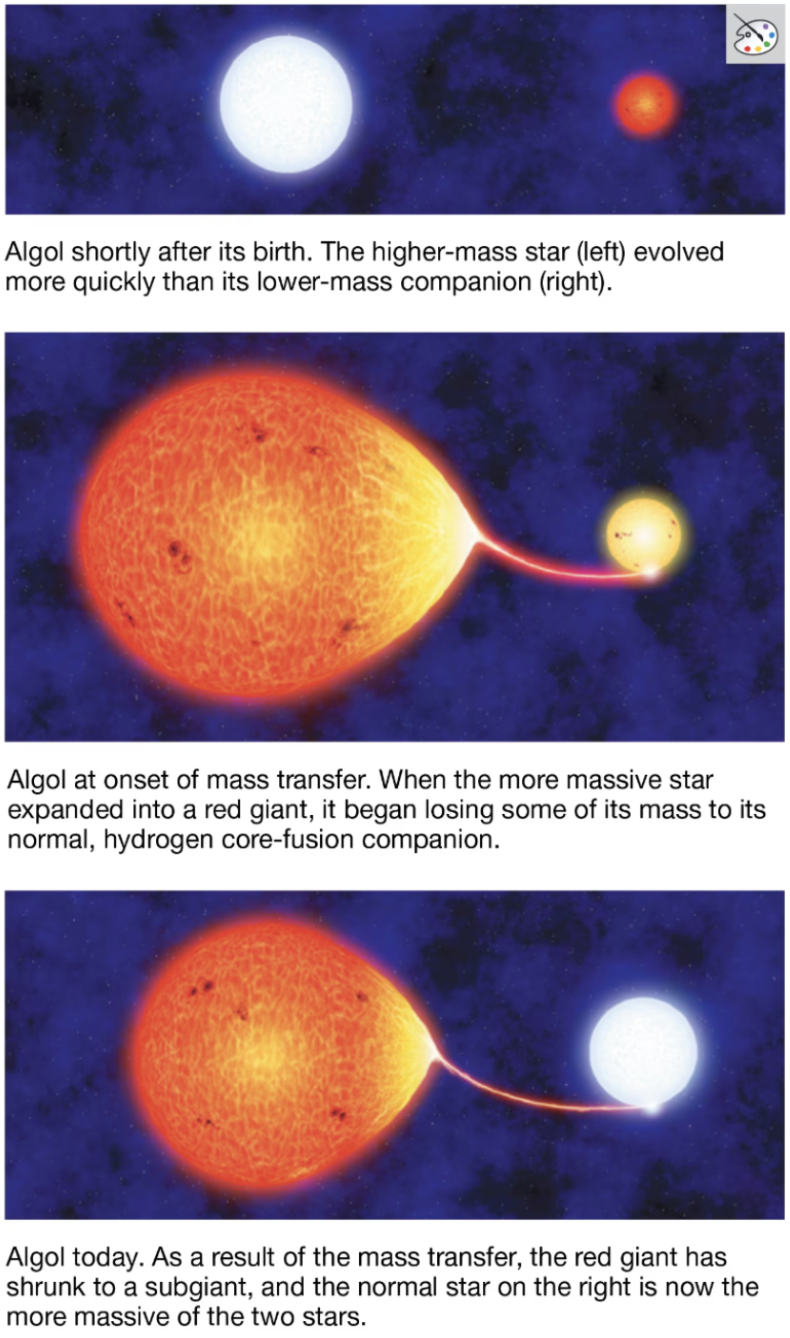
Recap: How does a star’s mass determine it’s life story?
Mass determines how high a star's core temperature can rise and therefore determines how quickly a star uses its fuel and what kinds of elements it can make
How are the lives of stars with close companions different?
Stars with close companions can exchange mass (binary system), altering the usual life stories of stars